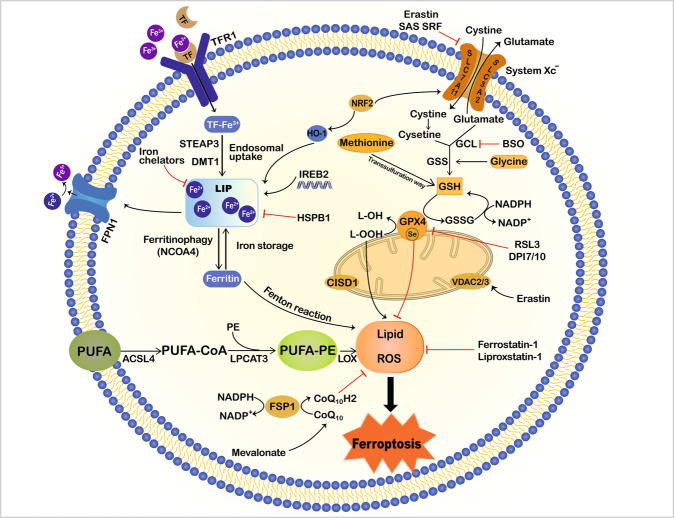Fig. 1. Mechanisms of ferroptosis.
Ferroptosis is characterised by iron accumulation, excessive ROS production and overwhelming lipid peroxidation. Three main metabolic pathways, amino-acid/GSH, lipid, and iron pathways, participate in the initiation and execution of ferroptosis. Moreover, there are additional signalling pathways and regulators controlling ferroptosis sensitivity. This illustration shows the process of ferroptosis, summarising the key molecules and targets that regulate iron and lipid peroxidation. ACSL4 acyl-CoA synthetase long-chain family member 4, BSO buthionine sulphoximine, CISD1 CDGSH iron sulphur domain 1, DMT1 divalent metal transporter 1, FSP1 ferroptosis suppressor protein 1, FPN1 ferroportin 1, GPX4 glutathione peroxidase 4, GSH glutathione, GSSG oxidized glutathione, GSS glutathione synthetase, GCL glutamate-cysteine ligase, HO-1 haem oxygenase 1, HSPB1 heat shock protein beta-1, IREB2 iron response element-binding protein 2, LOX lipoxygenase, LPCAT3 lysophosphatidylcholine acyltransferase 3, NCOA4 nuclear receptor coactivator 4, NRF2 nuclear factor E2-related factor 2, PUFA polyunsaturated fatty acid, PE phosphatidylethanolamine, ROS reactive oxygen species, RSL3 Ras-selective lethal 3, STEAP3 six-transmembrane epithelial antigen of prostate 3 metalloreductase, SLC7A11 solute carrier family 7 member 11, SAS sulphasalazine, SRF sorafenib, TF transferrin, TFR1 transferrin receptor 1, VDAC2/3 voltage dependent-anion channel 2/3.

